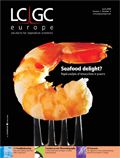Riva 2008
The 32nd International Symposium on Capillary Chromatography and the 5th GCXGC Symposium will be held at the Palazzo dei Congressi, Riva del Garda, Italy, in May.
The 32nd International Symposium on Capillary Chromatography and the 5th GC×GC Symposium will be held at the Palazzo dei Congressi, Riva del Garda, Italy, in May.

The International Symposium on Capillary Chromatography (ISCC) has, over the years, established its reputation as a leading forum on capillary chromatography and microcolumn separation techniques. Since the first meeting in Hindelang in 1975, important developments in these fields have been presented first in this symposium series.
The 32nd International Symposium takes place from 27–30 May, 2008 and will be the Silver Jubilee meeting as the first meeting held in Riva was in 1983. This year around 800 participants are expected to attend the presentation of the Marcel Golay Award. The lecture programme will consist of review papers by leading scientists covering the latest developments, keynote lecturers by young scientists, contributed papers presented in the "Riva" poster sessions as well as the discussion sessions. Workshop seminars of instrument manufacturers and an extensive exhibition of instrumentation, accessories and supplies will run in parallel to the scientific programme. The technical programme will cover capillary gas chromatography, micro liquid chromatography, electromigration methods, microfabricated analytical systems and lab-on-a-chip; column technology, coupled and multidimensional techniques; comprehensive techniques, sampling systems, sample preparation, trace analysis and automation within the application fields of environmental analysis; energy, petroleum and industrial analysis; biomedical and pharmaceutical analysis and analysis of natural products, food, flavours and fragrances.
Considering the present interest in comprehensive techniques, the fifth GC×GC Symposium will be organized during the same period to allow scientists to attend both meetings. The fifth GC×GC Symposium starts on Sunday, 25 May with a course covering the fundamental and practical aspects of comprehensive techniques and plenary sessions on Monday, 26 May.
To encourage scientific exchange and friendship building, the scientific programmes will be spiced with the well-known Riva social programme. This includes the welcome reception, cocktail party, classical concert, wine and cheese evening; disco night and then farewell cocktails. The "Riva experience" is one to be savoured and not missed.
For more information about Riva 2008 and to submit abstracts, visit www.richrom.com or e-mail: riva2008@richrom.com
20–23 May 2008
HET Instrument 2008 — Analysis, Biotechnology, Laboratory Equipment
Jaarbeurs Utrecht, Netherlands
Organizer: FHI Federation of Technology Branches
Contact: Ms Petra Bronsema
Tel: +31 33 465 75 07
Fax: +31 33 461 66 38
E-mail: p.bronsema@fhi.nl
3–6 June 2008
Forum LABO — Forum BIOTECH
Porte de Versaille, Paris, France
Organizer: Committee Interprofessional of Laboratory Suppliers (CIFL), 28, rue St Dominique,
75341 Paris, France
Contact: Ms Christiane Turci
Tel: +33 1 441898 62
Fax: +33 1 441898 63
Web:www.cifl.com/
20–22 October 2008
LABTECH Conference & Exhibition 2008
The Gulf International Convention and Exhibition Centre, PO Box 580, Kingdom of Bahrain,
Manama, Bahrain
Organizer: Saudi Aramco Co, ACS, SAICSC-ACS and Bahrain Society of Chemists
Contact: Yaser Sonbul
Address: Saudi Aramco Co., Box# 7010,
N/A Ras Tanura, 31311, Saudi Arabia
E-mail: vaser.sonbul@aramco.com
Send your event details tocbuckett@advanstar.com

HPLC 2025 Preview: Fundamentally Speaking (Part 1)
May 13th 2025Michael Lämmerhofer from the Institute of Pharmaceutical Sciences, University of Tübingen, Germany, spoke to JFK Huber Lecture Award winner of 2024 Torgny Fornstedt, professor in analytical chemistry and leader of the Fundamental Separation Science Group, Karlstad University, Sweden, about his pioneering work in high performance liquid chromatography (HPLC) with a focus on fundamentals and industrial applications.
Reversed-Phases for LC Deliberately Doped with Positive Charge: Tips and Tricks for Effective Use
May 13th 2025In this month's edition of LC Troubleshooting, Dwight Stoll and his fellow researchers discuss both the benefits (improved peak shape/loading) and challenges (excessive interaction) associated with charge-doped reversed-phase (RP) columns for both analytical and preparative separations.
Determining Ways to Protect Honeybee Colonies with GC–MS
May 13th 2025A study conducted by the Agriculture Research Centre of Giza, Egypt, and Jilin Agricultural University in China, evaluated the efficacy of stinging nettle extract, nettle smoke, and formic acid in the controlling of Varroa mites, a major threat to honeybee colonies, with a focus on mite infestation reduction, honeybee mortality, and biochemical responses. Gas chromatography–mass spectrometry (GC–MS) was used to identify key bioactive compounds in the stinging nettle extract.

.png&w=3840&q=75)

.png&w=3840&q=75)



.png&w=3840&q=75)



.png&w=3840&q=75)











